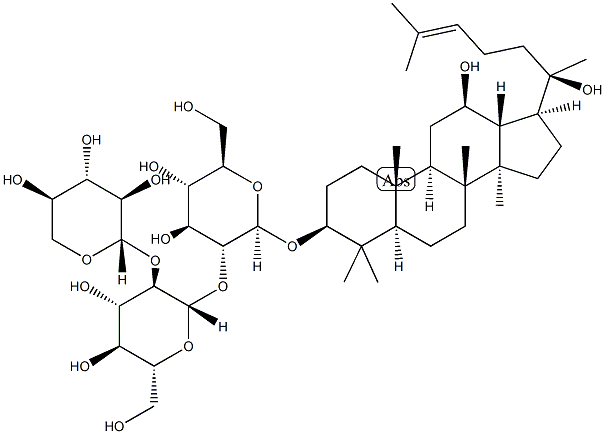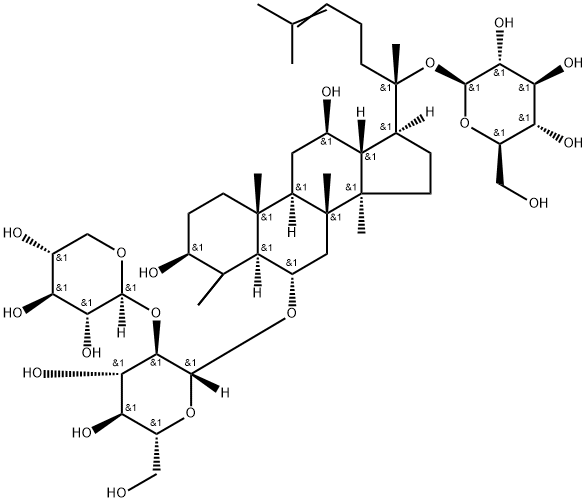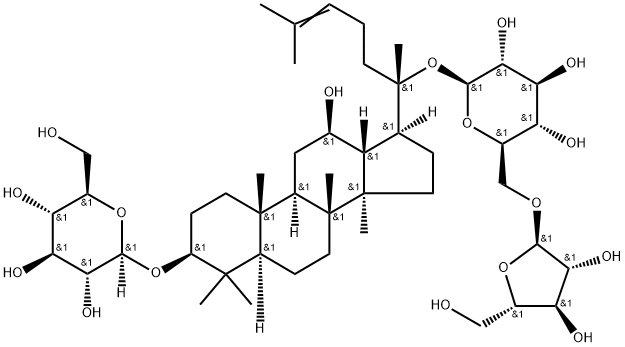NotoginsenosideFt1? , ≥98% , 155683-00-4
| Pack Size | Price | Stock | Quantity |
| 5mg | RMB656.00 | In Stock |
|
| 10mg | RMB820.80 | In Stock |
|
| others | Enquire |
PRODUCT Properties
| Boiling point: | 997.8±65.0 °C(Predicted) |
| Density | 1.36±0.1 g/cm3(Predicted) |
| solubility | DMF: 20 mg/ml; DMF:PBS(pH 7.2)(1:1): 0.5 mg/ml; DMSO: 15 mg/ml; Ethanol: 5 mg/ml |
| form | A crystalline solid |
| pka | 12.84±0.70(Predicted) |
| color | White to off-white |
Description and Uses
Notoginsenoside Ft1 is a saponin originally isolated from P. notoginseng with diverse biological activities. It induces proliferation, migration, and tube formation of human umbilical vein endothelial cells (HUVECs) via nuclear translocation of hypoxia-inducible factor-1α (HIF-1α) and activation of the PI3K/AKT and Raf/MEK/ERK signaling pathways in a manner dependent on mammalian target of rapamycin (mTOR). Notoginsenoside Ft1 (45 μM) induces cell cycle arrest at the S and G2/M phases and promotes apoptosis of SH-SY5Y cells. It increases cGMP levels and induces relaxation of isolated precontracted rat mesenteric arteries, effects that are reversed by the nitric oxide synthase inhibitor L-NAME and ODQ , an inhibitor of soluble guanylyl cyclase. In vivo, notoginsenoside Ft1 (0.25, 2.5, and 25 mg/kg) promotes angiogenesis and decreases wound diameter in a mouse model of punched-hole ear injury. Notoginsenoside Ft1 (1.25 mg/kg) decreases tail bleeding time and increases thrombus weight in a rat tail bleeding assay. Topical administration of notoginsenoside Ft1 increases mRNA expression of the collagen expression, fibroblast proliferation, and scar formation genes COL1A1, COL3A1, TGF-β1, TGF-β3, and fibronectin, promotes neovascularization, reduces monocyte infiltration, and shortens wound closure time in a db/db mouse model of diabetic foot ulcers.
Notoginsenoside Ft1 is a saponin isolated from Panax notoginseng; stimulator of angiogenesis. IC50 value: Target: angiogenesis stimulator in vitro: Ft1 increases translocalization of hypoxia-inducible factor-1α (HIF-1α) from cytoplasm to nuclei, where it binds to the vascular endothelial growth factor (VEGF) promoter, increasing the expression of VEGF mRNA and the subsequent secretion of the growth factor. Ft1 induces the activation of PI3K/AKT and Raf/MEK/ERK signaling pathways [1]. Among the saponins examined, Ft1 was the most potent procoagulant and induced dose-dependent platelet aggregation. Ft1 reduced plasma coagulation indexes, decreased tail bleeding time and increased thrombogenesis. Moreover, it potentiated ADP-induced platelet aggregation and increased cytosolic Ca(2+) accumulation, effects that were attenuated by clopidogrel. Ft1 binds to platelet P2Y12 receptors. The increase in intracellular Ca(2+) evoked by Ft1 in HEK293 cells overexpressing P2Y12 receptors could be blocked by ticagrelor [2]. Ft1 caused endothelium-dependent relaxations, which were abolished by l-NAME (inhibitor of nitric oxide synthases) and ODQ (inhibitor of soluble guanylyl cyclase). Ft1 increased the cGMP level in rat mesenteric arteries. GR and ER were present in the endothelial layer and their antagonism by RU486 and PHTPP, respectively, inhibited Ft1-induced endothelium-dependent relaxations and phosphorylations of eNOS, Akt and ERK1/2 [3]. Ft1 showed the best inhibitory effect on cell proliferation of SH-SY5Y cells with IC50 of 45μM. Ft1 not only arrested the cell cycle at S, G2/M stages, but also promoted cell apoptosis. Ft1 up-regulated the protein expressions of cleaved caspase 3, phospho-p53, p21, and cyclin B1, but down-regulated that of Bcl-2. Moreover, Ft1 enhanced the phosphorylation of ERK1/2, JNK and p38 MAPK [4]. in vivo: Ft1 promotes the formation of blood vessels in Matrigel plug and wound healing in mice [1].
Safety
| Symbol(GHS) |  GHS07 |
| Signal word | Warning |
| Hazard statements | H315-H319-H335 |
| Precautionary statements | P261-P264-P271-P280-P302+P352-P304+P340-P305+P351+P338-P312-P321-P362+P364-P332+P313-P337+P313-P403+P233-P405-P501 |




